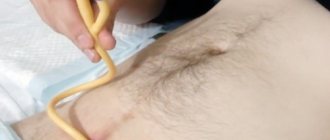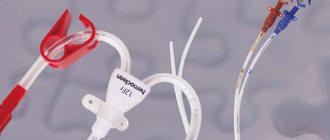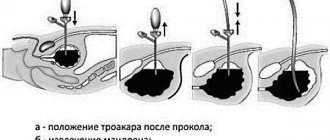Most men who have been prescribed a similar procedure perceive this event with some psychological discomfort, which is due to the need to penetrate the internal environment of the body, as well as the likely occurrence of discomfort and pain.
The main purpose of placing a urinary catheter is to normalize the outflow of urine from the lumen of the bladder. This event is especially relevant for people whose natural outflow of urine is impaired due to various diseases of the urinary tract.
A bladder catheter is a simple device consisting of one or more hollow tubes made of plastic or rubber. Depending on the severity and nature of the pathological changes, as well as the goals pursued, the catheter can be installed for a long or short period of time.
In addition to the function of emptying the bladder, this device allows you to administer various medicinal and antiseptic solutions directly into the bladder cavity. If the catheter placement technique is followed, this procedure is not accompanied by pain or severe discomfort.
When performing this manipulation, not only the level of qualification of the medical specialist is of great importance, but also compliance with the rules of antiseptics, which avoids the artificial introduction of pathogenic microorganisms into the urinary tract.
If the medical specialist is insufficiently qualified, as well as if the catheter placement technique is violated, trauma to the walls of the bladder and urethral region is possible. As a rule, this manipulation is carried out by representatives of nursing staff who have received instructions from the patient’s attending physician.
Types of catheters
From the point of view of the direct purpose of the catheter, two types can be distinguished - cavitary and vascular. The most striking example of the first type is urethral catheters, which are inserted into the bladder and serve to drain urine. In cases where natural emptying is impossible, installing this instrument becomes a real salvation for the patient. If insertion of a catheter through the urethra, due to some circumstances, is impossible, then the tube is installed percutaneously. In addition to the bladder, catheterization is used to compensate for dysfunctions of the following organs: gallbladder, kidneys, stomach.
Content:
- Types of catheters
- Features of catheterization
- Classification
- Materials for production
- Catheter Care
Another area of application for a cavity catheter is the treatment of cysts and internal inflammatory processes accompanied by the release of large amounts of pus. If the cyst reaches a large size, then before removing it, preliminary drainage of the fluid is required, which can be done by inserting the end of a hollow tube into it.
A vascular catheter is placed percutaneously into a vein. There are reasons for catheterization in patients who are indicated for a course of therapy based on regular intravenous interventions and injections. In this case, repeated damage to the vessel during drug administration can be avoided.
Indications
There is a whole list of pathological conditions for which an external male urological catheter of one of the mentioned types is used. For diagnostic purposes, this device is used to introduce contrasting components into the bladder cavity, followed by its subsequent X-ray examination.
In addition, the contents of the bladder are collected through a catheter for bacteriological and cytological examination. If the patient is in the rehabilitation period after surgery, then this procedure will allow medical specialists to monitor the level of daily diuresis.
As a therapeutic measure, the procedure for installing a urinary catheter is used for pathologies accompanied by disruption of the process of natural urine output. The most common reasons for performing this manipulation include:
- Kidney tuberculosis;
- Glomerulonephritis;
- Benign hyperplastic changes in the prostate;
- Blocking of the lumen of the ureter with renal stones in urolithiasis;
- Benign or malignant neoplasms that exert mechanical pressure on the urethra;
- Other reasons that contributed to the narrowing of the lumen of the urethra;
- This device is indispensable when it is necessary to directly administer antiseptic, anti-inflammatory and antibacterial drugs directly into the bladder cavity;
- Catheter placement is also performed in seriously ill patients, as well as in unconscious people.
Features of catheterization
Regardless of the type and reason for use, all catheters require mandatory fixation. The tube is secured to the skin using medical tape or suture material. Modern models are initially equipped with special clamps, which greatly facilitates the catheterization process. Additionally, it is necessary to set the position of the tube inside the cavity; most often, the instrument has a device that allows you to quickly change its shape after insertion into the hollow organ.
The most widely used system is the Pigtail system - the tip of the catheter made of polyvinyl material looks very similar to a pig's tail, hence the name. During production, this device is placed in a special stylet or conductor, and after installation it is released and, twisting, prevents the tube from falling out of the organ. This type of fixation system is recognized as the safest and easiest to implement.
For a more rigid fixation, a loop is used, which is tightened with a fishing line previously placed in the catheter cavity.
What does a Foley catheter look like?
The specified medical device has the shape of a tube with a balloon. The smooth side is inserted into the uterine cavity or bladder, and doctors promise minimal pain. However, in reality this is not the case, since instead of discomfort the patient experiences an attack of pain. Structurally, the device of a Foley catheter has several mandatory components. This:
- Foley balloon catheter. Necessary for strong fixation, it is structurally equipped with a plastic valve at the inlet. First, a therapeutic solution is injected into its cavity, after which the valve closes, deflating the balloon is completely eliminated.
- The Nelaton tip has a cylindrical, streamlined shape.
- Connector. Necessary for connecting the catheter to the cervix or bladder, resistant to kinking of the Foley tube.
Classification
Depending on the area of use, the following types of catheters are distinguished:
- aspiration – effective cleaning of the nasal and oral cavities in order to restore respiratory function;
- epidural - injected into the epidural space to administer anesthesia;
- urological – used in the absence of natural urination or urinary incontinence;
- umbilical - used in neonatology for cord blood transfusion;
- gastric - inserted into the stomach;
- trocar catheters – designed for the rapid drainage of fluid from the pleural cavity.
Despite the fact that many types have a similar structure, it is highly recommended not to replace them interchangeably. Such actions can cause complications.
Instructions for use
Before purchasing such a medical device, you need to further study the instructions and become familiar with all existing contraindications. Since this invasive method of inducing labor is characterized by its pain and psychological trauma, doctors have moved away from it and are using more progressive methods in practice. If it is decided that in a particular clinical picture it is appropriate to use a Foley catheter, the algorithm of actions in a hospital setting or hospitalization is presented below.
Staging
Before proceeding with manipulations, the doctor must do everything necessary to minimize the risk of extremely unwanted infection of the patient’s genitourinary area. Installation of a Foley catheter begins with careful cleaning of the vaginal surface with special antiseptic solutions. After this, the specialist proceeds to invasive manipulations. So:
- Installs mirrors under sterile conditions.
- Using a special clamp, a catheter is inserted into the cervix.
- Inflate the balloon with a sterile syringe to 10 ml of liquid.
- This pressure has a stimulating, tonic effect on the uterus, as a result of which it begins to contract vigorously.
- The device itself is attached to the inner thigh, the rest of the tubes are hidden in the vagina.
- If labor has not begun within 24 hours, its stimulation is no longer carried out with water or saline solution, but with Oxytocin.
- To remove fluid from the balloon during contractions, the doctor uses a special syringe, which manually pumps out the contents.
- Only a doctor should remove the catheter, otherwise you may injure the cervix.
Materials for production
The first medical catheters were made of durable materials - latex, elastomer or silicone rubber. They were inflexible and intended to be used over and over again. Gradually, other substances were replaced by silicone. The main advantage of this material is that it does not react with biological fluids. But there are also significant drawbacks - it is quite fragile, and in some cases small particles of the tube can remain inside the body, causing various complications.
Depending on the characteristics of the material used, all modern catheters are divided into soft and hard. The first ones are made of a special composition of rubber or polyvinyl chloride and can be used for both medicinal and surgical purposes.
The material for the manufacture of rigid catheters is metal. These tools are intended for the implementation of diagnostic measures.
For example, if a microcamera needs to be inserted into the stomach to visualize the state of its walls and mucous membrane, then the sensor is inserted using a metal tube. Modern catheters, made of high-quality polymer material that is safe and hypoallergenic, can be disposable or reusable.
Placement, replacement and care of a Foley catheter.
Placement of a Foley catheter.
Before inserting a catheter, hygiene procedures must be carried out.
The specialist must wash the patient’s hands and perineum with soap, disinfect with an antiseptic and wear sterile gloves. Prepare the catheter (take it with sterile tweezers, treat it with lubricant if necessary).
Catheter insertion procedure for women:
Lying on your back, bend and spread your legs.
Having parted the labia and found the opening of the urethra, carefully insert the catheter. As soon as urine flows through the catheter, you should stop.
After this, through one of the passages at the outer end of the catheter, inject sterile water with a syringe in a volume sufficient to inflate the balloon. Then attach a urine collection bag to the outer end. It is necessary to ensure that the bag is always below waist level to avoid urine backflow through the catheter.
Catheter insertion procedure for men:
In men, catheter placement is more difficult. Since the urinary canal is longer and has physiological narrowings. The patient needs to lie on his back and slightly bend his knees, relax, the catheter is inserted into the urethra slowly and smoothly, with rotational movements, squeezing the catheter with the 5th and 4th fingers of the right hand, and first the genital organ must be held vertically, and then tilted down. Advance the catheter carefully. The presence of urine indicates that the catheter is inserted correctly.
When placing a catheter, it is necessary to ensure psychological comfort for the child.
Disinfect the genital areas twice and wrap them with a sterile cloth. Lubricate the end of the catheter with, for example, Vaseline.
Do not forcefully insert the catheter if an obstruction is felt - this can damage the urethra.
The procedure for inserting a catheter is similar to that for adults, but the depth of insertion is less because the urethra is shorter.
Urinary catheter care:
Wash the area around the catheter with soap and water several times a day to help avoid irritating infection. Be sure to do this after every bowel movement. Women are washed from front to back.
Drain the urine bag in a timely manner, keeping it below the level of the bladder to prevent urine from flowing back into the catheter.
Catheter replacement:
If urine outflow is normal, the catheter is replaced as planned according to the doctor’s recommendation and instructions for use of the catheter.
Silicone ones have a shelf life of up to 30 days, latex ones up to 7 days, silicone with silver up to 90 days.
Never pull on the catheter. Disconnect the catheter only to flush or replace it, or to empty the urine bag.
Cases when you need to see a doctor:
- Abdominal pain, flakes and blood in the urine appear.
— Urine is leaking from under the catheter.
— The outflow of urine has ceased.
Reasons why urine may leak:
the catheter is too thin, the balloon is not inflated enough, the catheter or urinal tube is kinked, the catheter is blocked.
Reasons why urine stops coming out:
kinking of the catheter or urinal tube,
insufficient fluid intake into the body (increase the amount of fluid consumed),
the urine bag is fixed too high (lower it below the level of the bladder),
impaired renal function (anuria) as the patient’s condition worsens.
Urinary catheters are washed according to the doctor’s recommendation:
A warm saline solution is used for rinsing. If sediment or flakes appear in the urine, wash the catheter with a furatsilin solution, as well as miramistin or a chlorhexidine solution. For rinsing, use a Zhanne syringe.
source
Complications
If these manipulations are carried out incorrectly, or are the result of superficial self-medication, serious health consequences cannot be ruled out. The same applies to violation of contraindications. After a Foley catheter, the following clinical pictures cannot be excluded:
- pain when urinating;
- microtrauma of the cervix;
- inflammatory and infectious processes;
- exacerbation of bladder diseases;
- the need for surgical intervention;
- pathological childbirth;
- birth injuries.
Before buying such a tube with a package, you need to consult with your doctor to ensure there are no contraindications. If there are no restrictions, all that remains is to decide on the price of the issue. Purchasing online will be cheaper, but in order not to miss the choice, it is important to clarify the required catheter size. Prices in Moscow are as follows.
source
Changing the used package
A Foley catheter is convenient because the urine container can be used repeatedly, but you must carefully monitor its filling. Next, we will consider the algorithm for correctly changing and processing a liquid collection bag. After the patient has defecated, it is necessary to disconnect the catheter tube from the filled container. The bag should be washed with water, treated with an aqueous vinegar solution and dried. Before connecting a clean container to the catheter tube, the latter must be wiped with alcohol to prevent possible infection. After making sure that the tube is firmly connected to the bag, you need to open a special clamp that ensures the unhindered passage of urine. It is recommended to store liquid collection containers in dry paper bags until next use. It must be remembered that only a specialist with a medical education and appropriate skills in carrying out such procedures can change or remove a Foley catheter. If these rules are not followed, quite serious and dangerous complications may develop, the elimination of which will take a long time.
When selecting catheter size, it is important to take into account the patient's constitution, the specific procedure being performed, and the potential risks associated with it. Although catheter sizing depends on these and other variables, a good general rule is to select the smallest catheter available for the procedure. Many doctors use a 14 Ch Charrière catheter for adult men, which corresponds to a diameter of 4.7 mm, and for adult women a catheter that measures 12 - 16 Charrière Ch, which corresponds to a diameter of 4 - 5.3 mm .
If there is a possibility that excessive fluid or sediment such as blood clots will need to pass through the catheter, a slightly larger catheter should be used. Such risks are often associated with bladder catheterization, i.e. using a catheter to drain urine from the bladder. Problems can also occur during blood transfusion procedures.
When choosing a catheter for blood transfusion, the first consideration should be the size of the patient's vein.
Recent scientific developments have influenced standards regarding the size of blood transfusion catheters. Whereas previously the standard was an 18 Ch Charrière catheter, which corresponds to a diameter of 5.94 mm, the development of short peripheral catheters with thinner but stronger walls has made it possible to use smaller catheters to deliver larger volumes of fluid. Doctors now recommend using 18-20 Ch Charrière catheters (or 6.6 mm in diameter) only when large amounts of blood need to be rapidly transfused, such as in the event of injury.
The length of the catheter depends on the patient's constitution and the type of procedure being performed. Large, heavier patients may require a longer catheter tube than smaller, lighter patients. In addition, men need a longer urinary catheter than women. Typically, the length of urinary catheters for men is about 40 cm, while for women it is only about 15 cm. In all cases, however, the following must be taken into account: shorter catheters allow faster drainage of fluid; Longer catheter tubes create more resistance to fluid flow.
To increase the efficiency of catheterization, it is recommended to use a shorter catheter whenever possible.
In addition to the size, when choosing a catheter, you should also look at what material the catheter is made of and choose one that will be safe for the patient’s body, as well as those liquids whose transfusion involves the procedure. Most catheters are made of silicone or polyurethane, which softens when heated. Polyurethane is stiffer, which allows the catheter walls to be thinner and its internal diameter to be larger than that of silicone catheters. For these reasons, the use of a polyurethane catheter may increase the efficiency of catheterization and reduce the risk of irritation.
Catheterization of any part of the body is a delicate procedure. While minor irritation at the catheter site is normal, more severe irritation requires treatment. Urinary tract infections due to prolonged catheterization are the most common type of infection among hospital inpatients. For this reason, medical personnel are strongly advised to closely monitor catheterized patients. Self-catheterization is not recommended.
Source: wisegeek.com Photo: willbenurse.blogspot.com
See also:
- Why can't you combine grapefruit with simvastatin?
- Treatment of diabetes mellitus with gliclazide
- How to determine the dosage of cetirizine?
- What is epidural anesthesia?
- How are purulent plugs on the tonsils treated?
- What is pyruvate?
- What are sulfa drugs?
- How to control increased salivation?
- What to expect after gallbladder removal surgery?
- Development of antibiotic resistance
- Low sugar levels are good for the brain
- How to recognize inflammation of the lymph nodes
- Oral cells resist infections caused by Candida fungus
- Scientists are on the verge of inventing highly sensitive artificial skin
- Testosterone protects menopausal women's mental abilities
- Exposure to tobacco smoke causes DNA damage
- How does heredity affect the parkin protein?
A urological catheter is a tube-shaped device designed to evacuate urine from the urinary tract when independent urine discharge is impossible or very difficult due to injury or disease. The main determining requirements for a urological catheter are atraumaticity, elasticity, strength, maximum biocompatibility, and chemical stability.
Silicone is one of the most widely used and researched materials for the manufacture of urinary catheters, which differs in a number of ways.
- Maximum biocompatibility.
- Chemical inertness.
- Low surface tension.
- Chemical and thermal stability.
- Presence of hydrophobic properties.
Silicone has been used to make permanent and temporary catheters for over sixty years. This material does not cause local reactions and does not provoke salt deposition in the catheter lumen. Silicone elastomer is a thermosetting material that can withstand heat treatment at temperatures up to 230 ° C. The disadvantage of the elastomer is the relative high cost of production.
Latex is the sap of the rubber tree, stabilized by vulcanization (natural latex) or emulsion polymerization (synthetic latex). This is a highly elastic, durable, resistant material. Latex contains proteins, lipids, and inorganic salts. But it is the presence of proteins in latex that provokes the development of allergies when using its materials. Modern latex catheters are coated with silicone. The use of such a combination makes it possible to preserve the physical properties of latex and the high biocompatibility of silicone, as a result, allergies are eliminated while maintaining the high practicality of catheters.
Polyvinyl chloride is a thermoplastic synthetic material that is chemically stable and inert. Obtained by polymerization of vinyl chloride monomer. It has high flexibility, strength, and chemical resistance. Polyvinyl chloride is radiopaque. A significant advantage is the relatively low production cost. The main disadvantage of PVC is the use of plasticizers in its production, such as DEHP, which makes the initially hard and brittle PVC elastic, flexible and durable. DEHP can be toxic and cause local inflammatory reactions when used for long periods of time. Therefore, PVC is considered an obsolete material for the manufacture of urinary catheters, having given way to newer polymers.
Brass is a metal used for the manufacture of metal catheters. Used for making one-step emptying of the bladder before operations and during childbirth. Nowadays they are rarely used.
In addition to the material used to make the catheter, its internal and external coating plays an important role. Latex catheters are coated with silicone to reduce allergenicity, local inflammatory reactions and salt precipitation in the catheter lumen. For longer use of silicone catheters, they are coated with silver plating, which extends their service life to three months.
Preparing for catheter insertion
Before inserting the catheter, it is necessary to prepare the patient. Only a qualified, trained healthcare professional should insert a catheter. You can install a catheter by contacting the specialists of our clinic. If the patient is unable to seek help on his own, it is possible to call a urologist at home.
The patient is placed on oilcloth and a bedpan is placed under the buttocks. A button probe is used to insert a Petzer catheter. It must be inserted into the lumen of the catheter. In this case, the catheter cap in the form of a plate should stretch. The tip of the probe or mandrin should be at the blind end of the catheter. After insertion, the mandrin or probe is removed.
Urological care in our clinic is provided by the most experienced and qualified medical workers who regularly improve their skills.
How to choose a Foley catheter?
If we talk about which Foley catheter is better, then it is important to focus on the doctor’s indications and recommendations. This primarily depends on the duration of catheterization (periodic, temporary or lifelong, in which the patient always needs help to urinate). Also, when selecting, 3 aspects are taken into account:
- purpose of using the catheter,
- patient's age,
- product size.
The attending physician can determine the size needed for a particular patient. It is not recommended to do this yourself, because... The diameter of the tube is selected based on the size of the urethra and urethral canal. For example, its outer diameter can be 2.7 mm, with an internal diameter of 1.7 mm, or it can reach 8.7 mm, then the internal one will be 6.9 mm.
Advantages of the model
Urological Foley catheters are sterilized with ethylene oxide, therefore, with one-time use, infection is excluded. The packaging is designed in such a way that you do not have to remove the catheter before insertion. In the line you can choose options with different lengths and sizes of the cylinder, and in order to quickly determine the size, they are equipped with multi-colored caps.
The smooth surface makes insertion easy and the large lateral openings ensure efficient drainage. The cylinder is durable, and the connector connects to urinals of various designs.
What is it needed for
Catheterization of the bladder is an important procedure on the eve of surgery, since it can be used to both pump out fluid from the organ being examined and fill it with the medicine necessary for positive dynamics. Every doctor knows the algorithm for installing such a medical instrument; a detailed description is presented in the instructions. However, before you buy a device, it is important to carefully study what a Foley catheter is needed for. Medical indications during pregnancy are as follows:
- diabetes mellitus in a woman in labor;
- nursing pregnancy for more than 10 days;
- diseases of the cardiovascular system of the mother;
- weak labor activity;
- large fruit;
- polyhydramnios, multiple births;
- high blood pressure;
- severe gestosis;
- early removal of the plug;
- physical weakness of the woman in labor.
Foley catheter size chart:
| Floor | Size | Color | Inner diameter | External diameter | Length | Cylinder volume |
| Children's | Ch 6 | 1.1 mm | 2.0 mm | 28 cm | 3-5 ml | |
| Children's | Ch 8 | 1.7 mm | 2.7 mm | 28 cm | 3-5 ml | |
| Children's | Ch 10 | 2.3 mm | 3.3 mm | 28 cm | 3-5 ml | |
| Male, Female | Ch 12 | 2.8 mm | 4.0 mm | 39-40 cm | 30 ml | |
| Male, Female | Ch 14 | 3.3 mm | 4.7 mm | 39-40 cm | 30 ml | |
| Male, Female | Ch 16 | 3.8 mm | 5.3 mm | 39-40 cm | 30 ml | |
| Male, Female | Ch 18 | 4.5 mm | 6.0 mm | 39-40 cm | 30 ml | |
| Male, Female | Ch 20 | 5.1 mm | 6.7 mm | 39-40 cm | 30 ml | |
| Male, Female | Ch 22 | 5.6 mm | 7.3 mm | 39-40 cm | 30 ml | |
| Male, Female | Ch 24 | 6.2 mm | 8.0 mm | 39-40 cm | 30 ml | |
| Male, Female | Ch 26 | 6.9 mm | 8.7 mm | 39-40 cm | 30 ml | |
| Male | Ch 28 | 7.5 mm | 9.3 mm | 39-40 cm | 30 ml | |
| Male | Ch 30 | 8.0 mm | 10.0 mm | 39-40 cm | 30 ml |











